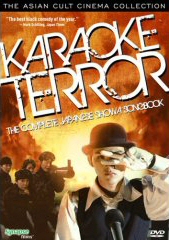
The horror genre dares peer closely at aspects of our lives -- and the species in general -- that other forms of entertainment and art possess neither the willingness or symbols to explore. Asian cinema has long been known for crossing lines of taboo while focusing on sexual, violent, and political themes that most films purposely avoid. A vivisection of morality and cultural decency, Karaoke Terror is both a celebration and condemnation of generational mistrust and resentment. A study of misunderstanding, this unflinching portrait of counter culture conflict is bordered in resentment, framed by blood, and painted in colors of ignorance and pain. Written by Ryu Murakami of Audition infamy, this story is sympathetic and nihilistic, tragic yet satirical. While the major point of warring age groups is about as subtle as a shovel to the side of the head, the emotional power and graphic presentation emphasizes the terrifying manner in which such misunderstandings spin out of control. A sometimes funny, often absurd, and consistently shocking look at the malevolence that one generation holds for another, Karaoke Terror is a powerhouse of resentment that throbs with contempt at the complacency of polite society.
The storyline of Karaoke Terror could have been ripped from current Japanese headlines. The plot taps into the resentment, confusion, and growing resentment that the youth and elderly feel towards one another. The Gakis, a group of young 20-somethings, don't know where their lives are headed or what emotional ties bind them but they enjoy their bi-weekly karaoke sessions. So do a group of middle aged women -- all divorcees -- called the Midoris, who do the same thing across town. It isn't long before these representatives from different cultural values become engaged in deadly battle. When one of the boys offers to have sex with one of the divorcees and is refused, he goes berserk and kills her. Ironically, this strengthens the women's bonds, and they vow revenge against the shiftless 20 somethings. As true today as it was when Shakespeare put quill to parchment, murder breeds murder, and soon the atrocities are piling high.
Generational conflict has long been a staple of storytelling. As the young become the old, having fought their elders for a place in the world, a new wave of youth -- angry, resentful, and hurt -- comes up behind them, continuing the cycle. This is captured in Karaoke Terror and mirrored by the mounting violence. While the US and Europe experiences there own generation gap, these issues are more dramatic in current Japanese society, where the deterioration of the 'traditional family' is being considered a harbinger of societal doom. As usual, instead of compromising or really seeking to understand one another, both groups simply seek to lay blame. This disregard has been taken to extremes before in such films as Battle Royale, but Karaoke Terror (a.k.a. The Complete Showa Era Song Book) treats it even more honestly (if not quite as graphically). A constant sense of absurdity is injected into this conflict, with the violence and comedy intimate enough to shock but broad enough to laugh at (in rather a heart-sick way). Both the Midoris and Gakis are groundless, empty, and without true purpose or happiness. Neither the boys are middle aged women share any real emotion or bond at first. These people don't even know themselves. Tetsuo Shinohara uses violence as the catalyst that makes each group more human to one another as they act barbaric to their enemies. He directs the mayhem with aplomb, injecting the dark satire with tension and pain. And no one is safe from condemnation. Murakami and Shinohara point the finger at both old and young, politicians and theorists. The very lack of any sense or decency is one of the film's telling points. Meanwhile you get mean spirited butchery, rage, and back-stabbing coated in the soundtrack of lame retro Karaoke tunes, adding just another layer of absurdity to the experience.
Synapse Films presents Karaoke Terror in an anamorphic widescreen of 1.85:1. The transfer is sharp and satisfying, and no grain or speckling ruins the experience. Colors are vivid and skin tones realistic. Audio is featured in Japanese Dolby Digital that is evenly balanced with no background interference. Optional English subtitles are included.
Synapse never skimps on extras and Karaoke Terror is no exception. Fluff free, a combination of interviews and features create a valuable context for better appreciating the movie. The most significant supplement is the "Making Of" segment featuring interviews with director Tetsuo Shinohara, Ryu Murakami, and assorted members of the cast. The movie, source material, and experience of filming are all discussed, as well as the major themes in a lively and informative manner. Liner Notes by Nicholas Rucka are entertaining and exhaustive and accompanied in an eight page booklet with a 'Written Guide to Karaoke and Enka," by Christine Yano. The Theatrical trailer, a Teaser, and a T.V. Spot are also included.
Review by William Simmons
| Released by Synapse |
| Region 1 - NTSC |
| Not Rated |
| Extras : |
| see main review |